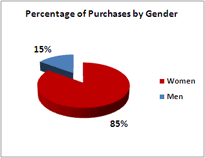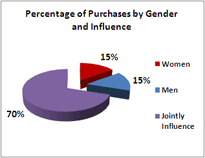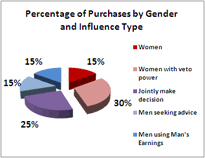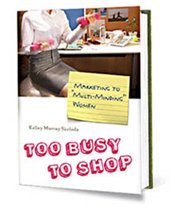Hey all — I’m happy to report that it is the end of the semester and, with it, the end to my Marketing Management course. It’s been a rough summer juggling classes (we had about three days off between terms), the real job, a couple of start-up projects, building a web site for a client, troubleshooting another site for that client and doing this Marketing to Women research. It’s been a wild ride and I’m looking forward to weekend trips, rounds of golf and all of the other things I have time to do now that I don’t have papers and tests to worry about for a month-plus.
In a short period of time, I’ve become incredibly passionate about the need for all marketers to better understand how to reach women in a compelling, honest way. I’ve had the good fortune of speaking with talented, successful marketers who have accomplished so much in their careers:
- Kelley Murray Skoloda (
 @toobusytoshop) at Ketchum (author of Too Busy to Shop)
@toobusytoshop) at Ketchum (author of Too Busy to Shop) - Mary Dean (
 @kickskirt), Founder of KickSkirt, who set standards for marketing to women with Curves and Levi’s
@kickskirt), Founder of KickSkirt, who set standards for marketing to women with Curves and Levi’s - Jen Drexler (
 @justaskawoman) at Just Ask a Woman (co-author of What She’s Not Telling You)
@justaskawoman) at Just Ask a Woman (co-author of What She’s Not Telling You) - Gerry Myers (
 @glmyers), CEO at Advisory Link (author of Targeting the New Professional Woman and co-author of Leading the Way to Success)
@glmyers), CEO at Advisory Link (author of Targeting the New Professional Woman and co-author of Leading the Way to Success) - Elisabet Rodriguez, CEO of Elisabet Rodriguez & Associates (author of the soon-to-be-released Can You Afford to Ignore Me? How to Manage Women from Different Ethnic Backgrounds)
This truly is the short list of people who’ve taken the time to answer my questions, from the silly to the sensationalistic. Hell, I even had a great Twitter exchange with Tom Peters (![]() @tom_peters), one of the few men consistently discussing this publicly, who kindly declined a request for an interview (*ahem*). In the end, I can’t thank everyone enough for their perspectives, guidance and continued support.
@tom_peters), one of the few men consistently discussing this publicly, who kindly declined a request for an interview (*ahem*). In the end, I can’t thank everyone enough for their perspectives, guidance and continued support.
The one question everyone keeps asking is, “what do you want to do with this when you’re done with the research?” I guess it threw me off because: 1) I hadn’t thought of it; and 2) unless I sprout a female brain, I don’t suspect that I’ll ever be done. My short answer is that I want to grow to be a better marketer and have the ability to compete in what is essentially a women’s market (as Tom Peters said, women are the leading buyers of “damn near everything”).
I’ve taken two things from this project: 1) the 90%+ of creative directors and the 75%+ of marketing executives who are male are acting as if nothing is changing in the way gender influences the market; and 2) as a result, there are few men educating themselves about how to stop insulting 35% of women and making the majority of them feel “vastly underserved”. Why is this a problem? Because companies end up making crappy products that are less useful than they should be and drive us consumers crazy. They make our lives more complicated rather than less so. Their products don’t feel right in our hands when we use them. They don’t have great customer service when their poorly-designed products break or don’t make sense. And the companies who are selling this stuff aren’t paying attention either, making the buying process painful and causing us think twice about buying the product in the first place. It makes everyone miserable. If women do, in fact, make or influence 85% of spending, then companies are loathe to forget one axiom — if mama ain’t happy, ain’t nobody happy.
Now that I’ve had some time to think about it, I have a long answer to that question. I’d like to help be a translator. I feel that marketing, user interface and customer service have the power to make the world a better place. I also feel that continuing to allow those areas to be driven almost entirely by men’s preferences is hurting, not helping. I’m not expecting miracles, but simply hope to nudge the process along. Perhaps my discoveries, many of which seem to obvious to women, will help my fellow male marketers. And I think that’s worth the time that will continue to go into this exploration.
Thank you all for reading and your feedback. I couldn’t be more appreciative. Keep it up — I need all the help I can get.
/abcjr









